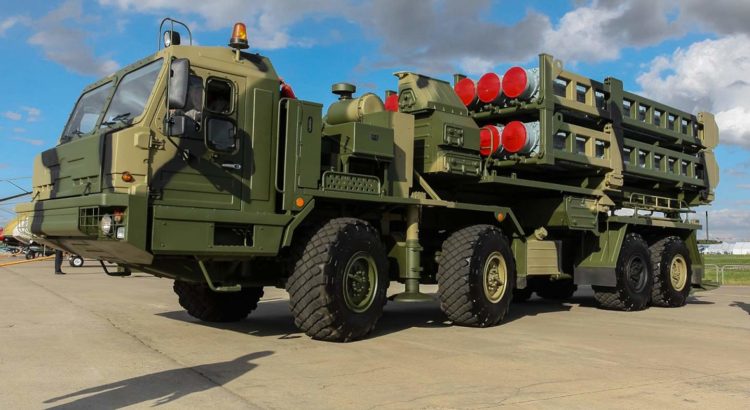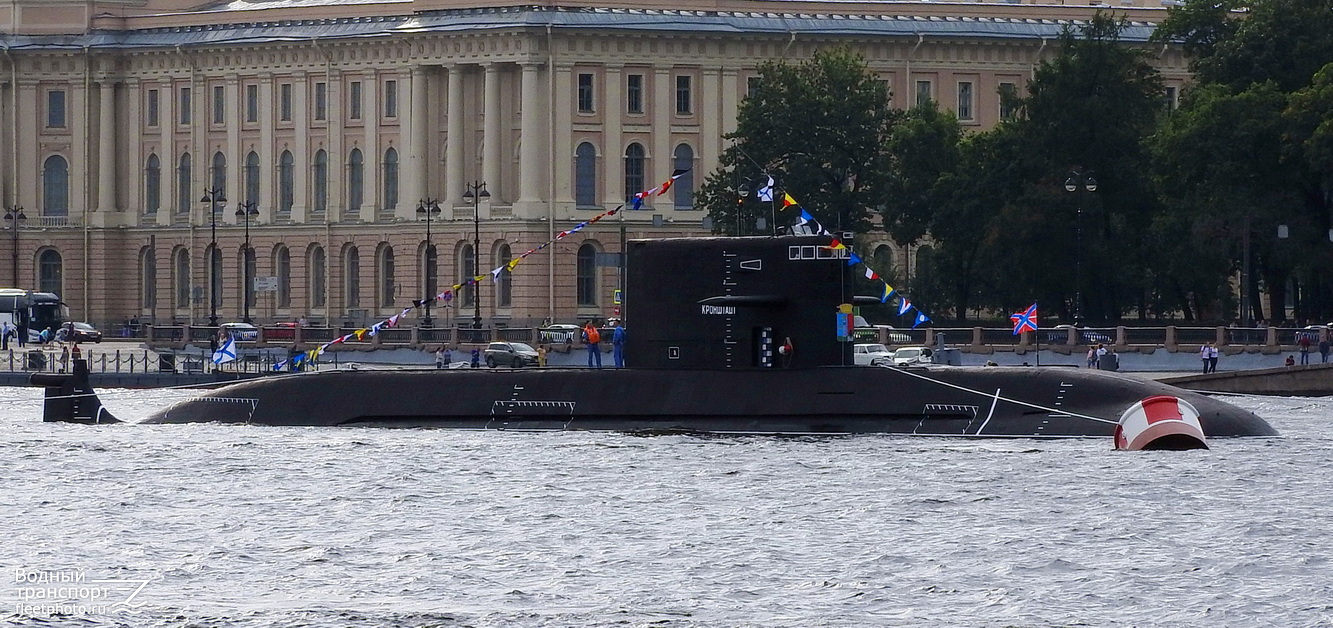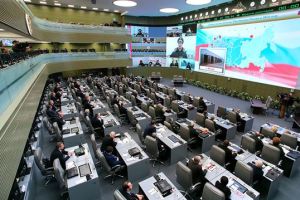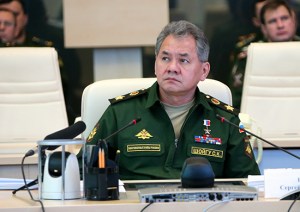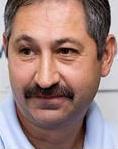The authors assess the program and its problems from a conservative viewpoint.
They assert the arms program is not being fulfilled and the MOD budget is being cut (whether admitted or not). In particular, they contend, it is new weapons programs that are suffering, so they argue for cheaper modernization of existing armaments.
Debate over rearmament is a constant. Staver and Skomorokhov don’t even mention that the start of the next arms program was delayed, or that the MOD and Finance Ministry are far apart on funding it.
For his part, Putin routinely says the current GPV will not be cut, and the armed forces will have 70 percent modern arms and equipment in 2020.
But 70 percent, according to the authors of this op-ed, is not enough. More is needed.
Then they turn to corruption. They allege that the ones who are “dizzy with the success” of the arms program are the ones who are stealing from it. They say a return to 1937 would put an end to this, and to other problems with rearmament.
Recall that even Putin and United Russia once talked about bringing treason charges for non-fulfillment of the GOZ, but nothing came of it.
So much for preamble.
“Dizzy with Success, or ‘Alarm’ in the Russian Army”
“We are so used to the fact that our army is powerful that we almost don’t notice, or more precisely, don’t wish to notice that light ‘clouds’ threatening to turn into bad storms have appeared over Russia’s VS [Armed Forces]. We talk and write with satisfaction about our aircraft which, at a minimum, don’t lag behind Western ones. We ‘procrastinate’ with Armata and its offshoots, comparing it to the best models of Western armies. We discuss the advantages of our new missiles and systems.”
“And now, today exactly, heard here and there are announcements by various government bureaucrats and army chiefs about delaying arms procurement to another time, so to speak. About delayed launches of ships. About adjusting the schedule for delivering something to the troops.”
“So what’s with this. Why is this happening? Recently all officials, including the president and the prime minister, together talked about fulfilling the defense order almost as a matter of honor for Russia. Don’t many remember Putin’s April statement about the unconditional fulfillment of the state defense order? And can’t many say exactly how much it is fulfilled and whether it is fulfilled?”
“The entire thing is that the necessary money is not in the budget! The crisis, which we are ‘successfully overcoming,’ still has us in its claws. We’ve talked a lot about the fact that sanctions hurt Europe and the USA, and how they [sanctions] are going to benefit us. We are developing, increasing output, winning markets… On any analytical program on our TV it’s possible to hear a full assortment of such pronouncements.”
“The support of the president and the real successes of our servicemen in Syria inspire hope in us that all this will come true. The government will find money both for us and for the army. Industry will begin to work not only well, but both quickly and cheaply. New ideas of [arms] designers will be realized in the shortest time.”
“Prime Minister Medvedev’s decision, signed on 5 September, to adjust the GOZ for 2016 was only the first call. It is understood that today there’s no clear data on this question. Naturally, it’s possible to suppose that defense sector enterprises won’t receive some part of the promised resources. And this, in its turn, means that GOZ plans for next year will be ruined. A snowball of corrections will accumulate gradually from the details.”
“And not hiding the fact, by the way, does him credit, Putin himself already talks about the fact that by 2018 our army will be rearmed at 70%, and the state order will be reduced. And he talks about what is needed to take the place of the defense order, but not pots and pans.”
“From the one side, one who is forewarned is forearmed. But from the other? It’s hard to guess with what enterprises will be occupied, with a miracle which drags them out of the debt hole. And where will workers who turn out to be redundant go at this moment? But we have already passed through such a scenario.”
“However, certain specifics have already ‘hatched.’ The Ministry of Defense plans to make the famous “Armata” the main battle tank by 2020. With this aim, the purchase of more than 2,000 of such vehicles for military units has been proposed. According to the tank producer’s data, the order was already for 2,300 tanks. But not long ago on the Ministry of Defense website an altogether different figure appeared: there is a plan to buy up to 70 “Armatas” in 2017-2019.”
“Naturally, the reasons for changing the [state defense] order aren’t named. I think over some time versions about some shortcomings, about the modernization of what we already have, [and] some others. Actually, the reason is banal. They are cutting the military budget and will cut it. It’s completely logical, you can’t take money from the shelf if there’s nothing on it. So folks say.”
“The navy’s situation looks even more confused. Even the blind see the necessity for modernizing the Russian fleet. Ships, just like people, age, lose their striking power, and turn into respected veterans. But we need warriors. And these ‘warriors’ need to be built. A lot of them. The Soviet legacy can no longer guarantee a worthy answer to an aggressor.”
“It seems as though construction began from 2007. Missile boats, small ships and even submarines began to leave the docks for testing. New submarines, frigates were laid down at the wharves. The rebirth had begun.”
“Our excessive belief in the ‘love and friendship of fraternal peoples’ became the first ‘obstacle.’ When construction was stopped by the Ukrainian side [sic]. They stopped supplying Ukrainian engines to us. Actually, the question of ‘their’ components in combat equipment and armaments arose already in the last century. And they successfully solved it in the USSR. But in Russia they put it off ‘for later.'”
“Then the ‘rockslide’ of announcements by military and government bureaucrats on cutbacks in the needs of the fleet began. I remind the readers about the project 11711 BDK [i.e. an LST]. A large assault ship which was needed to replace Soviet BDKs. In 2004, a requirement for 6 of such ships for the navy was announced. Then they decided to review the project.”
“Today we see two ships. Two instead of six. It’s been decided to shut down the project. ‘Ivan Gren’ and ‘Petr Morgunov’ — that’s all that the fleet will receive after testing.”
“It’s possible to talk endlessly about the submarine fleet. About new missile submarines. But even they, alas, for the most part remain only projects. The construction of boats of such a class is a very expensive undertaking. And this means still unmanageable.”
“Even the Rocket Troops of Strategic Designation [RVSN] will not receive everything promised. Although, for all times the priority was always right on these troops. No, ‘Yars’ and similar systems will be supplied. But land-based ‘Sarmat’ systems most probably won’t be deployed to the original plan.”
“I recall it was planned to replace by 2020 the already aged ‘Voyevod’ missiles (known to most by the NATO ‘nickname’ ‘Satan’) which have served out their time. Today it’s understood that these plans aren’t being fulfilled. Today already. In the best case, such a replacement will occur in 2021. Or a little later.”
“So where’s the way out of the situation which has been created? Is there one generally? I believe there is. And today the way out is to use those developments which exist and have already been tested in combat.”
“When the VDV [Airborne Troops] commander announced the establishment of tank and BMP companies in units subordinate to him, what kind of vehicles did he mention? He talked about T-72B3 tanks and BMP-2s. I hope no one will chide General Shamanov for stupidity and a lack of desire to have the most powerful and modern weaponry? So why exactly these vehicles?”
“Simply because both the tank and the combat vehicle have huge modernization potential. And in the coming decades this potential will be used. And mass serial production has reduced the cost of this equipment in the extreme. And long use in the troops has revealed practically all ‘minuses’ of these vehicles.”
“Modernization of the T-72 to the T-72B3 level costs a bit more than 50 million rubles. In other words, for one ‘Armata’ we can have several T-72B3s right away. Naturally, the T-90 would be more desirable, but it is cost prohibitive.”
“It’s exactly the same situation with the famous T-50 system. The aircraft is ready. Moreover, it’s been put in series production. And in the plans it’s supposed to be the main fighter. This ‘hulk’ looks impressive in our plans. In 2020 we should already have 60 fighters in the force. And in the future their production should increase.”
“In reality we’ll get exactly the same as ‘Armata.’ We want to do a ‘split,’ but our britches get in the way… It will be good if we have a regiment of such aircraft in 2020.”
“But we have the fully combat capable, even compared to the American F-22 and F-35, Su-30MK. And, according to the assertions of its builders, the potential of these aircraft is far from used up.”
“And what’s the result? As a result, we see the famous ‘half-full glass.’ Part of the readers are now sighing sadly. The army is ‘penned up.’ Another part thinks that the Russian Army, in the shape which we have it, can really confront the enemy. The third part giggles happily. They have failed to modernize. Oafs. We told them…”
“It’s not for nothing that I called this article by a Stalinist name. This isn’t a greatness mania or a wish to show off knowledge of the works of the ‘leader of peoples.’ We truly have become a little ‘dizzy.’ Not everything has succeeded right away.”
“I generally believe that the right way to move is walking or running. But not ‘leapfrog’ jumps. Movement should be measured and in one direction. Therefore, the modernization of the army should continue. Continue, no matter what. But not by busting a gut.”
“I would be wary of talking about our weapons and combat equipment like junk. Particularly after what this equipment showed in Syrian battles. Just the same to talk also about the superiority of Western armies in some components. But if we view the army like the world, a ‘gap’ will always be found. But this gap is always ‘plugged’ by something else.”
“The dizziness quickly passes if you leave the centrifuge or wheel. If, of course, you have a properly functioning outer office staff. I think healthy people serve in our Ministry of Defense.”
“But just one moment. No one needs to have the fact that our bureaucrats are not simply greedily stealing everything possible explained to them. It’s a rare day when the Internet and television don’t report about the latest stuff that’s ‘flown off.'”
“It’s necessary to stop those who ‘have become dizzy with success.’ With the methods of the person I quoted. Severe and long-term. Take that Zakharchenko. 9 billion rubles — that’s a great deal. The T-90, for example, today costs about 120 million rubles. That is 75 tanks laid in the brute’s hidey-holes. Two battalions. Not bad…”
“And this is one of the deputies…”
[Colonel Dmitriy Zakharchenko is, or was, deputy chief of Directorate T in the MVD’s Main Directorate of Economic Security and Countering Corruption until his arrest in early September. The foreign currency equivalent of 8 billion rubles was found in his apartment. See RIA Novosti for an early report on his case.]
“And if they search his relatives, it’s certain it would be possible to scrape together a brigade easily and without effort.”
“‘Effective managers’ of our times have shown that they can only steal effectively. From the budget just the same as from the GOZ.”
“It’s necessary to change the situation really at the root. And tear this root with a crunch and snap on the image and likeness of ’37. With the confiscation of everything that’s possible.”
“Only then will the state defense order be fulfilled on time and without problems. And the president won’t have to shuffle, talking about how 70 percent is sufficient so we should relax.”
“So isn’t it?”



